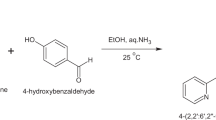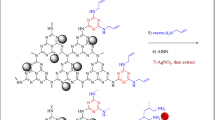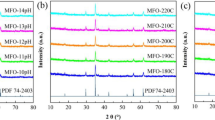Abstract
Silver nanoparticles (Ag NPs) were reduced on the surface of magnetic sporopollenin (Fe3O4@SP) modified with poly-dopamine to enhance the degradation capability for Rhodamine B (RhB). The polydopamine-coated Fe3O4@SP (PDA@ Fe3O4@SP) acts as a self-reducing agent for Ag+ ions to Ag0. The structural properties of the synthesized nanocomposite were determined using Fourier transform infrared spectrometry (FTIR), scanning electron microscopy (SEM), X-ray photoelectron spectroscopy (XPS), X-ray powder diffraction (XRD), inductively coupled plasma mass spectrometry (ICP-MS), and vibrating sample magnetometer (VSM). The systematic study of the degradation process was performed using Response Surface Methodology (RSM) to determine the relationship between the four process variables, namely, initial RhB concentration, NaBH4 amount, catalyst amount, and time. Optimum points were determined for these four parameters using both matrix and numerical optimization methods. Under optimum conditions, RhB was decolorized with a yield of 98.11%. The apparent activation energy (Ea) and rate constant (k) for the degradation were 24.13 kJ/mol and 0.77 min−1, respectively. The reusability studies of the Ag@PDA@Fe3O4@SP exhibited more than 85% degradation ability of the dye even after five cycles. As a result, Ag@PDA@Fe3O4@SP possessed high catalytic activity, fast reduction rate, good reusability, easy separation, and simple preparation, endowing this catalyst to be used as a promising catalyst for the decolorization of dyes in aqueous solutions.









Similar content being viewed by others
Availability of data and materials
Not applicable.
References
Ahmad NF, Kamboh MA, Nodeh HR, Halim SNBA, Mohamad S (2017) Synthesis of piperazine functionalized magnetic sporopollenin: a new organic-inorganic hybrid material for the removal of lead(II) and arsenic(III) from aqueous solution. Environ Sci Pollut Res 24:21846–21858. https://doi.org/10.1007/s11356-017-9820-9
Ai L, Zeng C, Wang Q (2011) One-step solvothermal synthesis of Ag-Fe3O4 composite as a magnetically recyclable catalyst for reduction of Rhodamine B. Catal Commun 14:68–73. https://doi.org/10.1016/j.catcom.2011.07.014
Ain QU, Rasheed U, Yaseen M, Zhang H, Tong Z (2020) Superior dye degradation and adsorption capability of polydopamine modified Fe3O4-pillared bentonite composite. J Hazard Mater 397:122758. https://doi.org/10.1016/j.jhazmat.2020.122758
Aisien F, Amenaghawon N, Ekpenisi E (2013) Photocatalytic decolourisation of industrial wastewater from a soft drink company. J Eng Appl Sci 9:11–16
Ball V (2018) Polydopamine nanomaterials: recent advances in synthesis methods and applications. Front Bioeng Biotechnol 6. https://doi.org/10.3389/fbioe.2018.00109
Baran T, Sargin I, Kaya M, Menteş A, Ceter T (2017) Design and application of sporopollenin microcapsule supported palladium catalyst: remarkably high turnover frequency and reusability in catalysis of biaryls. J Colloid Interface Sci 486:194–203. https://doi.org/10.1016/j.jcis.2016.09.071
Bose S, Kumar Tripathy B, Debnath A, Kumar M (2021) Boosted sono-oxidative catalytic degradation of Brilliant green dye by magnetic MgFe2O4 catalyst: degradation mechanism, assessment of bio-toxicity and cost analysis. Ultrason Sonochem 75:105592. https://doi.org/10.1016/j.ultsonch.2021.105592
Chen H, Li Y, Wang S, Zhou Y (2017) Synthesis of montmorillonite/Fe3O4-OTAB composite capable of using as anisotropic nanoparticles. Appl Surf Sci 402:384–391. https://doi.org/10.1016/j.apsusc.2017.01.103
Chen B, Long F, Chen S, Cao Y, Pan X (2020) Magnetic chitosan biopolymer as a versatile adsorbent for simultaneous and synergistic removal of different sorts of dyestuffs from simulated wastewater. Chem Eng Sci 385:123926. https://doi.org/10.1016/j.cej.2019.123926
Chirra S, Wang L-F, Aggarwal H, Tsai M-F, Soorian SS, Siliveri S, Goskula S, Gujjula SR, Narayanan V (2021) Rapid synthesis of a novel nano-crystalline mesoporous faujasite type metal-organic framework, ZIF-8 catalyst, its detailed characterization, and NaBH4 assisted, enhanced catalytic Rhodamine B degradation. Mater Today Commun 26:101993. https://doi.org/10.1016/j.mtcomm.2020.101993
Das TK, Ganguly S, Bhawal P, Remanan S, Mondal S, Das NC (2018) Mussel inspired green synthesis of silver nanoparticles-decorated halloysite nanotube using dopamine: characterization and evaluation of its catalytic activity. Appl Nanosci 8:173–186. https://doi.org/10.1007/s13204-018-0658-3
Deng H, He H, Sun S, Zhu X, Zhou D, Han F, Huang B, Pan X (2019) Photocatalytic degradation of dye by Ag/TiO2 nanoparticles prepared with different sol–gel crystallization in the presence of effluent organic matter. Environ Sci Pollut Res 26:35900–35912. https://doi.org/10.1007/s11356-019-06728-0
Dyab AK, Abdallah EM, Ahmed SA, Rabee MM (2016) Fabrication and characterisation of novel natural Lycopodium clavatum sporopollenin microcapsules loaded in-situ with nano-magnetic humic acid-metal complexes. J Encapsulation Adsorpt Sci 6:109
Ecer Ü, Şahan T, Zengin A (2021a) Synthesis and characterization of an efficient catalyst based on MoS2 decorated magnetic pumice: an experimental design study for methyl orange degradation. J Environ Chem Eng 9:105265. https://doi.org/10.1016/j.jece.2021.105265
Ecer Ü, Zengin A, Şahan T (2021b) Magnetic clay/zeolitic imidazole framework nanocomposite (ZIF-8@Fe3O4@BNT) for reactive orange 16 removal from liquid media. Colloid Surf A 630:127558. https://doi.org/10.1016/j.colsurfa.2021.127558
Gola D, Kriti A, Bhatt N, Bajpai M, Singh A, Arya A, Chauhan N, Srivastava SK, Tyagi PK, Agrawal Y (2021) Silver nanoparticles for enhanced dye degradation. Curr Res Green Sustain Chem 4:100132. https://doi.org/10.1016/j.crgsc.2021.100132
Gubbuk IH (2011) Isotherms and thermodynamics for the sorption of heavy metal ions onto functionalized sporopollenin. J Hazard Mater 186:416–422. https://doi.org/10.1016/j.jhazmat.2010.11.010
Hassan AM, Wan Ibrahim WA, Bakar MB, Sanagi MM, Sutirman ZA, Nodeh HR, Mokhter MA (2020) New effective 3-aminopropyltrimethoxysilane functionalized magnetic sporopollenin-based silica coated graphene oxide adsorbent for removal of Pb(II) from aqueous environment. J Environ Manage 253:109658. https://doi.org/10.1016/j.jenvman.2019.109658
He K, Yan M, Huang Z, Zeng G, Chen A, Huang T, Li H, Ren X, Chen G (2019) Fabrication of ploydopamine–kaolin supported Ag nanoparticles as effective catalyst for rapid dye decoloration. Chemosphere 219:400–408. https://doi.org/10.1016/j.chemosphere.2018.12.012
Ismail M, Khan MI, Khan SB, Khan MA, Akhtar K, Asiri AM (2018) Green synthesis of plant supported CuAg and CuNi bimetallic nanoparticles in the reduction of nitrophenols and organic dyes for water treatment. J Mol Liq 260:78–91. https://doi.org/10.1016/j.molliq.2018.03.058
Jeyapragasam T, Kannan RS (2016) Microwave assisted green synthesis of silver nanorods as catalysts for rhodamine B degradation. Russ J Phys Chem 90:1334–1337. https://doi.org/10.1134/S003602441607030X
Jyoti K, Baunthiyal M, Singh A (2016) Characterization of silver nanoparticles synthesized using Urtica dioica Linn. leaves and their synergistic effects with antibiotics. J Radiat Res Appl Sci 9:217–227. https://doi.org/10.1016/j.jrras.2015.10.002
Khan ZUH, Shah NS, Iqbal J, Khan AU, Imran M, Alshehri SM, Muhammad N, Sayed M, Ahmad N, Kousar A, Ashfaq M, Howari F, Tahir K (2020) Biomedical and photocatalytic applications of biosynthesized silver nanoparticles: ecotoxicology study of brilliant green dye and its mechanistic degradation pathways. J Mol Liq 319:114114. https://doi.org/10.1016/j.molliq.2020.114114
Kim MR, Lee DK, Jang D-J (2011) Facile fabrication of hollow Pt/Ag nanocomposites having enhanced catalytic properties. Appl Catal B 103:253–260. https://doi.org/10.1016/j.apcatb.2011.01.036
Kohri M, Kohma H, Shinoda Y, Yamauchi M, Yagai S, Kojima T, Taniguchi T, Kishikawa K (2013) A colorless functional polydopamine thin layer as a basis for polymer capsules. Polym Chem 4:2696–2702. https://doi.org/10.1039/C3PY00181D
Kong H, Jang J (2008) Synthesis and antimicrobial properties of novel silver/polyrhodanine nanofibers. Biomacromol 9:2677–2681. https://doi.org/10.1021/bm800574x
Kumar A, Mishra B, Tripathi BP (2020) Polydopamine assisted synthesis of ultrafine silver nanoparticles for heterogeneous catalysis and water remediation. Nano-Struct Nano-Objects 23:100489. https://doi.org/10.1016/j.nanoso.2020.100489
Kurtan U, Amir M, Yıldız A, Baykal A (2016) Synthesis of magnetically recyclable MnFe2O4@SiO2@Ag nanocatalyst: its high catalytic performances for azo dyes and nitro compounds reduction. Appl Surf Sci 376:16–25
Li G, Li Y, Wang Z, Liu H (2017) Green synthesis of palladium nanoparticles with carboxymethyl cellulose for degradation of azo-dyes. Mater Chem Phys 187:133–140
Li Y, Lu H, Wang Y, Li X (2019) Deposition of Au nanoparticles on PDA-functionalized PVA beads as a recyclable catalyst for degradation of organic pollutants with NaBH4 in aqueous solution. J Alloys Compd 793:115–126. https://doi.org/10.1016/j.jallcom.2019.04.148
Li Y, Wang Y, Lu H, Li X (2020a) Preparation of CoFe2O4–P4VP@Ag NPs as effective and recyclable catalysts for the degradation of organic pollutants with NaBH4 in water. Int J Hydrog Energy 45:16080–16093. https://doi.org/10.1016/j.ijhydene.2020.04.002
Li Z, Yuan C-G, Guo Q, Wei X (2020b) Preparation of stable AgNPs@PAN/GO-SH nanocompsite by electrospinning for effective degradation of 4-nitrophenol, methylene blue and Rhodamine B. Mater Chem 265:127409. https://doi.org/10.1016/j.matlet.2020.127409
Lu Z, Xiao J, Wang Y, Meng M (2015) In situ synthesis of silver nanoparticles uniformly distributed on polydopamine-coated silk fibers for antibacterial application. J Colloid Interface Sci 452:8–14. https://doi.org/10.1016/j.jcis.2015.04.015
Mishra K, Poudel TN, Basavegowda N, Lee YR (2016) Enhanced catalytic performance of magnetic Fe3O4–MnO2 nanocomposites for the decolorization of rhodamine B, reduction of 4-nitroaniline, and sp3 C-H functionalization of 2-methylpyridines to isatins. J Catal 344:273–285. https://doi.org/10.1016/j.jcat.2016.09.020
Mondal A, Adhikary B, Mukherjee D (2015) Room-temperature synthesis of air stable cobalt nanoparticles and their use as catalyst for methyl orange dye degradation. Colloid Surf A 482:248–257
Nalbandian L, Patrikiadou E, Zaspalis V, Patrikidou A, Hatzidaki E, Papandreou N, C, (2016) Magnetic nanoparticles in medical diagnostic applications: synthesis, characterization and proteins conjugation. Curr Nanosci 12:455–468
Naseem K, Begum R, Wu W, Irfan A, Al-Sehemi AG, Farooqi ZH (2019) Catalytic reduction of toxic dyes in the presence of silver nanoparticles impregnated core-shell composite microgels. J Clean Prod 211:855–864. https://doi.org/10.1016/j.jclepro.2018.11.164
Şahan T, Öztürk D (2014) Investigation of Pb(II) adsorption onto pumice samples: application of optimization method based on fractional factorial design and response surface methodology. Clean Technol Envir 16:819–831. https://doi.org/10.1007/s10098-013-0673-8
Salama A, Mohamed A, Aboamera NM, Osman TA, Khattab A (2018) Photocatalytic degradation of organic dyes using composite nanofibers under UV irradiation. Appl Nanosci 8:155–161. https://doi.org/10.1007/s13204-018-0660-9
Sen TK, Afroze S, Ang HM (2011) Equilibrium, kinetics and mechanism of removal of methylene blue from aqueous solution by adsorption onto pine cone biomass of Pinus radiata. Water Air Soil Pollut 218:499–515. https://doi.org/10.1007/s11270-010-0663-y
Su S, Guo W, Leng Y, Yi C, Ma Z (2013) Heterogeneous activation of oxone by CoxFe3 − xO4 nanocatalysts for degradation of rhodamine B. J Hazard Mater 244–245:736–742. https://doi.org/10.1016/j.jhazmat.2012.11.005
Touqeer T, Mumtaz MW, Mukhtar H, Irfan A, Akram S, Shabbir A, Rashid U, Nehdi IA, Choong TSY (2020) Fe3O4-PDA-lipase as surface functionalized nano biocatalyst for the production of biodiesel using waste cooking oil as feedstock: Characterization and process optimization. Energies 13:177
Uzuriaga-Sánchez RJ, Khan S, Wong A, Picasso G, Pividori MI, Sotomayor MDPT (2016) Magnetically separable polymer (Mag-MIP) for selective analysis of biotin in food samples. Food Chem 190:460–467. https://doi.org/10.1016/j.foodchem.2015.05.129
Vanaja M, Annadurai G (2013) Coleus aromaticus leaf extract mediated synthesis of silver nanoparticles and its bactericidal activity. Appl Nanosci 3:217–223. https://doi.org/10.1007/s13204-012-0121-9
Veerakumar P, Chen S-M, Madhu R, Veeramani V, Hung C-T, Liu S-B (2015) Nickel nanoparticle-decorated porous carbons for highly active catalytic reduction of organic dyes and sensitive detection of Hg(II) ions. ACS Appl Mater Interfaces 7:24810–24821. https://doi.org/10.1021/acsami.5b07900
Wang J, Zhang Q, Shao X, Ma J, Tian G (2018) Properties of magnetic carbon nanomaterials and application in removal organic dyes. Chemosphere 207:377–384. https://doi.org/10.1016/j.chemosphere.2018.05.109
Yılmaz Ş, Zengin A, Ecer Ü, Şahan T (2019) Conversion from a natural mineral to a novel effective adsorbent: utilization of pumice grafted with polymer brush for methylene blue decolorization from aqueous environments. Colloid Surf A 583:123961. https://doi.org/10.1016/j.colsurfa.2019.123961
Zhang Y, Zhu P, Chen L, Li G, Zhou F, Lu D, Sun R, Zhou F, Wong C-p (2014) Hierarchical architectures of monodisperse porous Cu microspheres: synthesis, growth mechanism, high-efficiency and recyclable catalytic performance. J Mater Chem 2:11966–11973. https://doi.org/10.1039/C4TA01920B
Author information
Authors and Affiliations
Contributions
Ümit Ecer: investigation, data analysis, material synthesis and characterization, writing—original draft preparation, and experiments. Tekin Şahan: data analysis, experiments, methodology, material synthesis and characterization, writing—reviewing and editing. Adem Zengin: data analysis, experiments, methodology, material synthesis and characterization, writing—reviewing and editing. İlkay Hilal Gübbük: investigation and data analysis.
Corresponding authors
Ethics declarations
Ethics approval
The authors all agree to ethical approval and understand its related rules and content.
Consent to participate
The authors of this manuscript are all aware of the journal to which the manuscript was submitted, and all agree to continue to support the follow-up work.
Consent for publication
This manuscript has not been submitted or published in other journals, and the authors agree to consent to publish.
Conflict of interest
The authors declare no competing interests.
Additional information
Responsible Editor: Guilherme L. Dotto
Publisher's note
Springer Nature remains neutral with regard to jurisdictional claims in published maps and institutional affiliations.
Supplementary Information
Below is the link to the electronic supplementary material.
Rights and permissions
About this article
Cite this article
Ecer, Ü., Şahan, T., Zengin, A. et al. Decolorization of Rhodamine B by silver nanoparticle–loaded magnetic sporopollenin: characterization and process optimization. Environ Sci Pollut Res 29, 79375–79387 (2022). https://doi.org/10.1007/s11356-022-21416-2
Received:
Accepted:
Published:
Issue Date:
DOI: https://doi.org/10.1007/s11356-022-21416-2




